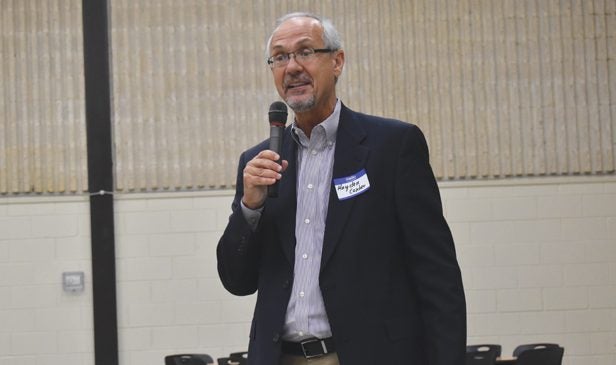Annual substance abuse forum offers hope during opioid crisis
Published 12:02 am Friday, October 28, 2022

- Dr. Hayden Center of Walden University was the keynote speaker at Thursday's annual Substance Abuse Forum at the Civic Center. Photo by Elisabeth Strillacci
SALISBURY — Just the word “addiction,” let alone the actual health issue, still carries a stigma that can interfere with people’s willingness to get help and the community’s willingness to give support.
But every year, Rowan County Public Health and partners come together in a forum to talk about how to deal with the ongoing misuse of substances like opiates and the underlying and connected health issues.
At this year’s event, compassion and hope were evident as keynote speaker Dr. Hayden Center said approaches have changed for the better. A licensed professional counselor (LPC) specializing in addiction issues for over 30 years and a faculty member at Walden University, Center teaches in the Clinical Mental Health Counseling Program.
He touched on issues of inequality in the treatment of addiction, or more appropriately the misuse of certain chemicals, depending on a variety of issues, from economic to race to sexual orientation, but more importantly, he discussed the stigma that continues to surround the issue.
“Historically we have used language to isolate,” he said. “For instance, we say ‘she’s schizophrenic,’ rather than ‘she suffers from the disease schizophrenia.’ Back in the cave man days, our survival depended in large part on sticking together in groups. Being kicked out of the group was a matter of life and death. Today, we are still kicking people out of the group, and for them, it is still a matter of life and death.”
In addition to working to reduce the stigma, Center said the medical field needs to continue to change its approach to treatment, “because we have been treating a chronic condition as if it is acute, and that won’t work. We have seemed to think six, 12, 24 weeks of treatment is enough to solve the problem, but substance use meets all the definitions of chronic. There are treatments that work, though nothing is ever 100 percent, but this is a lifelong issue.”
He said treatment needs to be ongoing, and those seeking help should not be denied treatment “just because they are not ‘following the steps.’ We don’t tell a heart patient ‘well, you’re not following the exact diet we gave you so we aren’t going to treat you anymore,’ and we should not treat those dealing with a substance use issue any differently.”
Chief Bryan Edwards of Rowan County EMS agreed that things have changed. He said that in the 1980s, as a paramedic, he could count on one hand the number of times in a year he would dispense Narcan. Now, it could be dispensed as much as 10 times a day, and a decent percentage of those receiving it are not getting it for the first time.
“Studies have shown that the longer care is delayed, the less likely we are to have a good outcome, so what we offer in terms of medical care in the field is exactly what you would get in the hospital,” he said. “Except you are not being transported automatically. So if I give an overdose patient Narcan, and they come to and decline to go to the hospital, despite my best advice, I can’t force them to go. I can’t take them against their will, so I know the follow up is not happening.”
Which is where Desiree Dunston of Novant Health Rowan Medical Center came in, presenting an update on the future detox and crisis facility that is in the planning stages. The optimistic goal, she said, is for the separate facility to open its doors by fall of 2024, but between now and then, an organization will need to be selected to run the center and a strategic plan of sustainability will have to be developed. But it will not only take some of the strain off the local emergency department, but will provide a full range of services that local hospitals just cannot.
“Right now, there are parents who, when their children just become too much for them to handle, will drive up and drop them off at the emergency department door,” she said. “That’s not effective for the young people or the hospital.”
But the plan to open such a center is a tremendously hopeful goal that everyone in attendance Thursday was excited about.
“The story of addiction and the long-lasting ripple effect of substance use undermine all aspects of health here in Rowan County,” said Public Health Director Alyssa Harris. “We heard Chief Edwards share that 75 percent of (overdose) reversals that EMS go to may have a child present in the home during that visit; we know that a majority of our children in Rowan County that are in foster care are there due to parental substance use. We know that we have a higher rate of overdose deaths and a higher rate of naloxone reversals than the state average and those counties that surround. We know these metrics and more prevent Rowan County from being a truly healthy community.
“The work of addressing substance use has grown over time. We are where we are because we build on the people who came before us in addressing this work. It is much easier today to talk about substance use than it was even 5 years ago. In 2017, Rowan County Public Health began our part of the conversation about substance use through our opioid epidemic forum for community leadership. That forum generated ideas and those themes included educating youth, developing a community task force, increasing services for treatment, starting program for inmates, helping pregnant patients have healthy babies, and creating a safe and healthy environment that fosters recovery in our community. In reviewing past forums, one thing that stuck out to me is that five years ago our community and county commissioners called for accountability from pharmaceutical companies for their role in the opioid epidemic to fund these ideas. I am pleased to share that we now have $15.1 million coming into Rowan specifically in response to the opioid epidemic through the work of Attorney General Joshua Stein and the opioid settlement.”
The health department has, Harris said, a comprehensive plan that spans the length of the settlement – 15 to 17 years — with plans to carry forward unused funds to ensure level funding over time. The last thing we want it to see the funding spent down without it adding up to true healing and change for our community. For the funding, there is a strategic direction and budget approved from commissioners, including positions for a new program manager and coordinator, and bringing on a new team to lead Collaborative Strategic Planning with an equity approach in mind. The current plan includes a strong focus on early intervention, naloxone distribution and training for all first responders, harm reduction, and to continue and to build out the post-overdose response team by bringing on additional peer support specialists and support of community paramedics.
“This is a multifaceted issue that deserves a comprehensive response,” she said. “As the health department was selected as the lead agency for these funds, we pledge that we will be transparent and accountable for ensuring there is change in the community. I ask that you hold us to that statement.”






